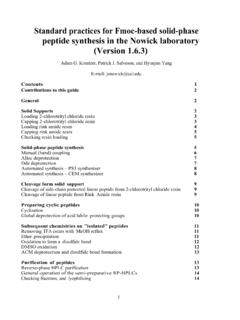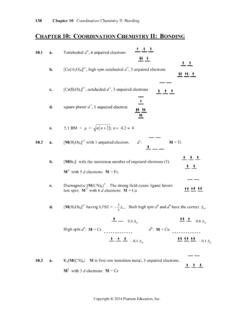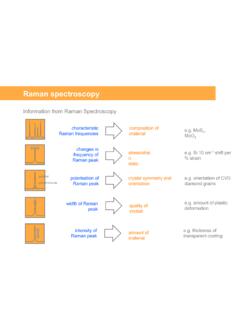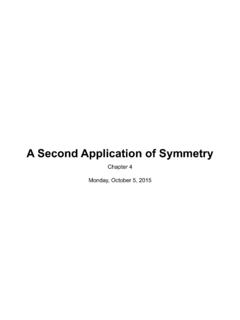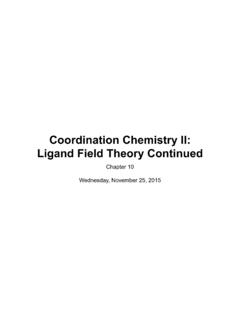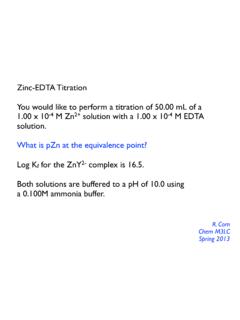Transcription of Multiplet Guide and Workbook - University of California ...
1 Multiplet Guide and Workbook (J. Nowick)There are a limited number of first-order multiplets that are typically encountered in 1H NMR spectroscopy. In addition to the simple couplings involving equivalent coupling constants [doublet (d), triplet (t), quartet (q), quintet, sextet, septet, octet, and nonet], there are more complex patterns involving different coupling constants. Common patterns include the doublet of doublets (dd), doublet of triplets (dt), triplet of doublets (td), doublet of doublet of doublets (ddd), and a few involving more than three couplings (dddd, dq, qd, tt, ddt, dtd, tdd, etc.). The following examples and problems are designed to help you better understand these couplings. CONTENTS:Quartet (q) exampleTriplet (t) worksheetDoublet of doublets (dd) exampleDoublet of doublets (dd) worksheetDoublet of doublet of doublets (ddd) exampleDoublet of doublet of doublets (ddd) worksheetTriplet of doublets (td) exampleTriplet of doublets (td) worksheetDoublet of triplets (dt) exampleDoublet of triplets (dt) worksheetIt should be noted that there are two conflicting systems of nomenclature that are in use.
2 (Alas, I can show you authoritative sources supporting each system.) For the purposes of this course, we will name multiplets such that the biggest coupling constant determines the "first name" of the Multiplet and the smallest coupling constant determines the "last name." In this system of nomenclature, a doublet of triplets (dt) is six-line pattern with one large coupling and two equal small couplings. It may be thought of as a "pair of triplets." Conversely, a triplet of doublets (td) is a six-line pattern with two equal large couplings and one small coupling. It may be thought of as a "trio of doublets in 1:2:1 ratio".It should also be noted that the approach taken in this Guide is based on pattern recognition and is complementary to the purely analytical approach described by Hoye and coworkers (J. Org. Chem. 1994, 59, 4096 and J.)
3 Org. Chem. 2002, 67, 4014). The analytical approach, although particularly powerful for the most complex splitting patterns ( , dddd), suffers the disadvantage that it tends to result in experimentally insignificant differences in coupling constants being determined ( , dddd, J = , , , Hz vs. quintet, J = Hz). It also does not perform well in complex multiplets in which lines cannot be resolved. For this reason, I prefer the pattern-recognition approach described of doublet of doublet of doublets (dddd) exampleDoublet of doublet of doublet of doublets (dddd) worksheetTriplet of triplets (tt) exampleTriplet of triplets (tt) worksheetDoublet of quartets (dq) exampleDoublet of quartets (dq) worksheetDoublet of Doublet of Triplets (ddt)Doublet of Triplet of Doublets (dtd)Triplet of Doublet of Doublets (tdd)Doublet of Triplet of Doublets (dtd) examplesinglet (s)doublet (d)triplet (t)quartet (q)quintetsextetdoublet ofdoublets (dd)doublet ofdoublet ofdoublets (ddd)doublet oftriplets (dt)doublet oftriplets (dt)triplet ofdoublets (td)doublet ofdoublet ofdoublet ofdoublets(dddd)doublet ofdoublet ofdoublet ofdoublets(dddd)triplet oftriplets (tt)doublet ofquartets (dq)triplet ofdoublet ofdoublets (tdd)
4 Doublet oftriplet ofdoublets (dtd)doublet ofdoublet oftriplets (ddt)1 QuartetDescription: A quartet (q) is a pattern of evenly-spaced lines with 1:3:3:1 relative intensities (or close to 1:3:3:1 relative intensities) that are separated by the coupling constant J. The quartet arises from coupling with equal coupling constants to three protons (or other spin 1/2 nuclei).Example: q, J = 7 HzA quartet may be thought of as a doublet of doublet of doublets with three equal splittings and the following splitting tree, which has been represented as three successive Hz7 Hz7 Hz7 Hz7 Hz7 Hz7 Hz7 Hz7 Hz111211331 The J value of a quartet can always be determined by measuring the distances between individual lines. With real data, it is best to take the average distance between lines (which is also the distance between the first and last line divided by three).
5 Simulation of a quartet J = 7 Hz gives the familiar : A triplet (t) is (FINISH DESCRIPTION)Example: t, J = 6 Hz (DRAW A SPLITTING TREE AND GRAPH THE Multiplet . Use a scale of 1 box is equal to 1 Hz on the horizontal axis and accurately represent the relative heights of the lines on the vertical axis.)A triplet may be thought of as doublet of doublets with two equal splittings. (DRAW THE SPLITTING TREE AS TWO SUCCESSIVE DRAWINGS.)The J value of a triplet can always be determined by (FINISH THE DESCIPTION)Simulation of a triplet J = 6 Hz (PROVIDE A SIMULATION USING THE " " SPREADSHEET)3 Doublet of DoubletsDescription: A doublet of doublets (dd) is a pattern of up four lines that results from coupling to two protons (or other spin 1/2 nuclei). The lines are of all equal intensities (or close to equal intensities). If both of the coupling constants are the same, a triplet (t) occurs.
6 Example: dd, J = 14, 10 HzThe smaller J value of a dd is always the distance between the first and second line (or the third and fourth line). The larger J value of a dd is the distance between the first and third line (or the second and fourth). Simulation of a dd (J = 14, 10 Hz) gives a typical four-line Hz10 Hz10 of Doublets (continued)Example: dd, J = 14, 3 Hz (DRAW THE SPLITTING TREE AND GRAPH THE Multiplet . Use a scale of 1 box is equal to 1 Hz on the horizontal axis and accurately represent the relative heights of the lines on the vertical axis.)Simulation of a dd J = 14, 3 Hz (PROVIDE A SIMULATION USING THE " " SPREADSHEET)5 Doublet of Doublets Examples: 3,3-Dimethyl-1-butene010-1020 (dd, J = , Hz, 1H) (dd, J = , Hz, 1H) (dd, J = , Hz, 1H)010-1020 Hz 1211109876543210240220200180160140120100 806040200 CDCl3QE-300 6 Doublet of Doublet of DoubletsDescription: A doublet of doublets of doublets (ddd) is a pattern of up to eight lines that results from coupling to three protons (or other spin 1/2 nuclei).
7 The lines may be of all equal intensities (or close to equal intensities) or may overlap to give lines of greater intensities. If all of the coupling constants are the same, a quartet (q) occurs. If the two smaller coupling constants are the same, a doublet of triplets (dt) occurs. If the two larger coupling constants are the same a triplet of doublets (td) occurs. Example: ddd, J = 12, 8, 6 HzThe smallest J value of a ddd is always the distance between the first and second line (or the last and next to last line). The middle J value of a ddd is always the distance between the first and third line (or the last and second from last line). The largest J value of a ddd may be either the distance between the first and fifth line or the first and fourth, but is always the distance between the first and last lines minus the smallest and middle J values.
8 (It is the distance between the first and fifth if the largest J is greater than the sum of the smaller two J's.) Simulation of a ddd (J = 12, 8, 6 Hz) gives the the typical eight-line Hz8 Hz8 Hz6 Hz6 Hz6 Hz6 of Doublet of Doublets (continued)Example: ddd, J = 14, 10, 4 Hz (DRAW THE SPLITTING TREE AND GRAPH THE Multiplet . Use a scale of 1 box is equal to 1 Hz on the horizontal axis and accurately represent the relative heights of the lines on the vertical axis.)Simulation of a ddd J = 14, 10, 4 Hz (PROVIDE A SIMULATION USING THE " " SPREADSHEET)8 Doublet of Doublet of Doublets Examples: trans-2-Phenylcyclopropanecarboxylic acid010-1020 Hz-20010-1020 Hz-20010-1020 (ddd, J = , , Hz, 1H) (ddd, J = , , Hz, 1H) (ddd, J = , , Hz, 1H) (ddd, J = , , Hz, 1H)010-1020 Hz-20 1211109876543210240220200180160140120100 806040200 CDCl3 + DMSO-d6QE-300 PhCO2H9 Triplet of DoubletsDescription: A triplet of doublets (td) is a pattern of three doublets, in a 1:2:1 ratio of relative intensities, that results from coupling to two protons (or other spin 1/2 nuclei) with a larger J value and one proton (or other spin 1/2 nucleus) with a smaller J value.
9 Example: td, J = 10, 3 HzThe J value of the doublet is always the distance between the first and second line (or the second and the third, or the fifth and the sixth ). (I generally take the average of these values in analyzing the data.) The J value of the triplet is always the distance between the first and third line (the second and fourth, or the third and fifth, or the fourth and sixth . (I generally take the average of these values in analyzing the data.) Simulation of a td J = 10, 3 Hz:10 Hz10 Hz3 Hz3 Hz3 HzA triplet of doublets may be thought of as a triplet with 1:2:1 relative intensities. Each line of this triplet is further split into a doublet. The splitting tree has been represented as two successive Hz10 Hz3 Hz3 Hz3 of Doublets (continued)Example: td, J = 10, 7 Hz (DRAW A SPLITTING TREE AND GRAPH THE Multiplet .))
10 Use a scale of 1 box is equal to 1 Hz on the horizontal axis and accurately represent the relative heights of the lines on the vertical axis.)Simulation of a td J = 10, 7 Hz (PROVIDE A SIMULATION USING THE " " SPREADSHEET)11 Triplet of Doublets Example: trans-2-Phenylcyclohexanol010-1020 (td, J = , Hz, 1H) 1211109876543210240220200180160140120100 806040200 CDCl3QE-300 OHPh12 Doublet of TripletsDescription: A doublet of triplets (dt) is a pattern of two triplets, in a 1:1 ratio of relative intensities, that results from coupling to one proton (or other spin 1/2 nuclei) with a larger J value and two protons with a smaller J value. Example: dt, J = 18, 7 HzThe smaller J value of a dt is always the distance between the first and second line (or the fifth and sixth ). (I generally take the average of these values in analyzing the data.
